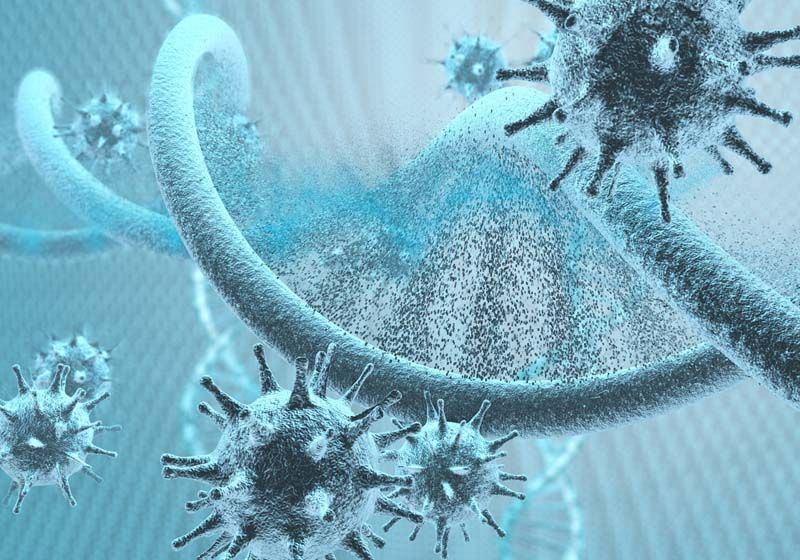CRISPR-Cas9 technology holds promise for treating inherited disorders, but scientists are also exploring its utility for excising integrated viruses. Early reports have demonstrated that CRISPR effectively excises integrated human immunodeficiency virus type 1 (HIV) from cells.1,2 For Michele Lai from the University of Pisa, these studies raised an important question: what happens to the excised DNA?
He set out to answer this question, and recently published in the Journal of Virology that some of the excised viral DNA molecules form stable DNA circles that can reintegrate into the genome.3 This phenomenon may pose a challenge to those working on CRISPR-based HIV treatments.
Even if CRISPR works in 100 percent of T cells, you would still have a good number of cells where the [plasmids] can start the infection over.
—Mauro Pistello, University of Pisa
“In this context of genomic instability, the cell doesn't understand what is the DNA of the cell and what is the virus. I hypothesized that mechanisms of DNA repair may create a circle of viral DNA that is more resistant to [degradation],” Lai said.
To test this idea, Lai and his colleagues treated HIV infected cells with CRISPR and used a technique to specifically amplify circular viral DNA. This enabled them to detect tiny plasmids carrying viral sequences in CRISPR-treated cells.
“We did some calculations, and there was about one every 1,000 cells,” said Mauro Pistello, senior author of the paper. “Even if CRISPR works in 100 percent of T cells, you would still have a good number of cells where the [plasmids] can start the infection over.”
When the researchers sequenced the viral plasmids, they found that nearly all contained an intact LTR. The LTR serves as HIV’s promoter to activate transcription,2 so Lai wondered if the viral plasmids could enable a cell to produce viral proteins.
To find out, Lai mixed the plasmids with HIV proteins that transcribe the viral genome and saw that they indeed formed infectious virions, albeit at a low rate.3

“The idea that even if you have successful gene therapy-mediated excision of the virus, it can reassemble into something functional is a very provocative scenario that should be further investigated in primary cells or animal models,” said Satish Pillai from the Vitalant Research Institute and the University of California, San Francisco (UCSF), who was not involved in the study. “Understanding what the fate is of the excision products and the cells that harbor these excision products will be critical in designing a functional and safe gene therapy strategy in the future.”
As development of this strategy moves forward, Lai and his coauthors propose revising CRISPR approaches to cut the HIV genome into multiple fragments. “The idea of a multi-targeting strategy to combat HIV with gene therapy now has two tiers of support: deter evolution of viral resistance, and dramatically reduce or even eliminate the possibility that the virus could reassemble into a functional molecule,” Pillai stated.
However, this solution reduces gene therapy efficacy and increases the chances of cutting unintended genomic locations.7,8 As they move forward, Lai, Pistello, and their collaborators will continue refining their strategy to find a happy medium between avoiding viral reassembly and maintaining host cell genomic integrity in pursuit of a safe and effective gene therapy for HIV.
References
- H. Ebina et al., “Harnessing the CRISPR/Cas9 system to disrupt latent HIV-1 provirus,” Sci Rep, 3:2510, 2013.
- P.K. Dash et al., "Sequential LASER ART and CRISPR treatments eliminate HIV-1 in a subset of infected humanized mice,” Nat Comm, 10(1):2753, 2019.
- M. Lai et al., "CRISPR/Cas9 ablation of integrated HIV-1 accumulates proviral DNA circles with reformed long terminal repeats,” J Virol, 95(23):e0135821, 2021.
- M.E. Barry et al., “Role of endogenous endonucleases and tissue site in transfection and CpG-mediated immune activation after naked DNA injection,” Hum Gene Ther, 10(15):2461-80, 1999.
- M. Kosicki et al., “Repair of double-strand breaks induced by CRISPR-Cas9 leads to large deletions and complex rearrangements,” Nat Biotechnol, 36(8): 765-71, 2018.
- G. Magro et al., “Targeting and understanding HIV latency: the CRISPR system against the provirus,” Pathogens, 10(10): 1257, 2021.
- “CRISPR guide,” Addgene, https://www.addgene.org/guides/crispr/
- M. Naeem et al., “Latest developed strategies to minimize the off-target effects in CRISPR-Cas-mediated genome editing,” Cells, 9(7): 1608, 2020.





